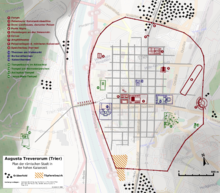Asclepius Temple Trier
The Asclepius Temple Trier is an ancient temple on the banks of the Moselle in the Roman city of Augusta Treverorum , today's Trier . According to a discovery of inscriptions, it was dedicated to the god of healing Asclepius .
temple
On the grounds of the Borromeo Hospital , from 1977 to 1979, when an underground car park was being built, larger wall sections were uncovered, which took up an area of 170 × 88 m and thus more than the entire width of the insula near the banks of the Moselle. To build it, considerable embankments were made on the river for flood protection. Together with the large buildings of the Barbarathermen , the monumental temple is likely to have largely dominated the cityscape above the Moselle bridge.
A podium temple was uncovered in the northern part of the portico- framed courtyard . The podium was 45 × 26 m in size. The foundation of the cella (32.5 × 17 m) was exposed at an even distance of 3.20 m from the outer edge . It had an apse or monumental niche on the northern narrow side to accommodate a statue of the god. Reinforcing walls in this area suggest an equally monumental statue. Only part of the back wall of the temple has been preserved in a parking garage.
Finds
An extraordinarily large coin treasure was discovered on the northern edge of the facility in Feldstrasse in 1993 (→ Trier gold coin treasure ). It contained 2570 aurei with a total weight of 18.5 kg. The latest coins come from the reign of Septimius Severus , the coin hoard is now in the Rheinisches Landesmuseum (RLM).
As early as 1734, a building and dedicatory inscription and a marble figure of Asclepius were discovered in the area of the then Johanniter-Kommende. The sculpture was brought to Metz, where it has been lost ever since. The inscription is in the RLM. It refers to the consecration of a portrait by the finance procurator Titus Iulius Saturninus, who resides in Trier, and can be dated to the period between 161 and 169 AD based on the imperial formula. Based on the finds, the construction of the temple itself can be set in the last third of the 1st century AD.
literature
- Heinz Cüppers : The Temple of Asklepios on the Moselle Bridge in Trier. In: Kurtrierisches Jahrbuch 22, 1982, pp. 7-13.
- Sabine Faust: Pagan temple districts and cult buildings. In: Alexander Demandt, Josef Engemann (ed.): Konstantin der Große. Emperor Caesar Flavius Constantinus . Philipp von Zabern, Mainz 2007, ISBN 978-3-8053-3688-8 , p. 328.
- Karl-Josef Gilles: Temple districts in the Trier region. In: Religio Romana. Paths to the gods in ancient Trier. Exhibition catalog Rheinisches Landesmuseum Trier 1996, ISBN 3-923319-34-7 , pp. 74–76 ( publications of the Rheinisches Landesmuseum Trier 12).
- Markus Trunk : Roman temples in the Rhine and western Danube provinces: A contribution to the architectural-historical classification of Roman sacred buildings in Augst. Augst 1991, ISBN 3-7151-0014-1 , pp. 225f. ( Research in Augst 14).
Web links
Individual evidence
- ↑ Karl-Josef Gilles: The Roman gold coin treasure from Feldstrasse in Trier . Trier 2013, ISBN 978-3-923319-82-4 ( Trier magazine supplement 34).
- ^ Hans-Peter Kuhnen : Trier: Archeology and history of a Roman metropolis. In: H.-P. Kuhnen (ed.): The Roman Trier. Theiss, Stuttgart 2001, pp. 31 and 39 ( Guide to archaeological monuments in Germany 40); Sabine Faust: banks of the Moselle: Roman temple. In: Rheinisches Landesmuseum Trier (ed.): Guide to archaeological monuments of the Trier region. Trier 2008, p. 52f. ( Series of publications by the Rheinisches Landesmuseum Trier 35 ).
- ↑ CIL 13, 3636 .
- ↑ Heinz Cüppers in: H. Cüppers (Ed.): The Romans in Rhineland-Palatinate. P. 591f.
Coordinates: 49 ° 45 ′ 13.1 ″ N , 6 ° 37 ′ 55 ″ E


